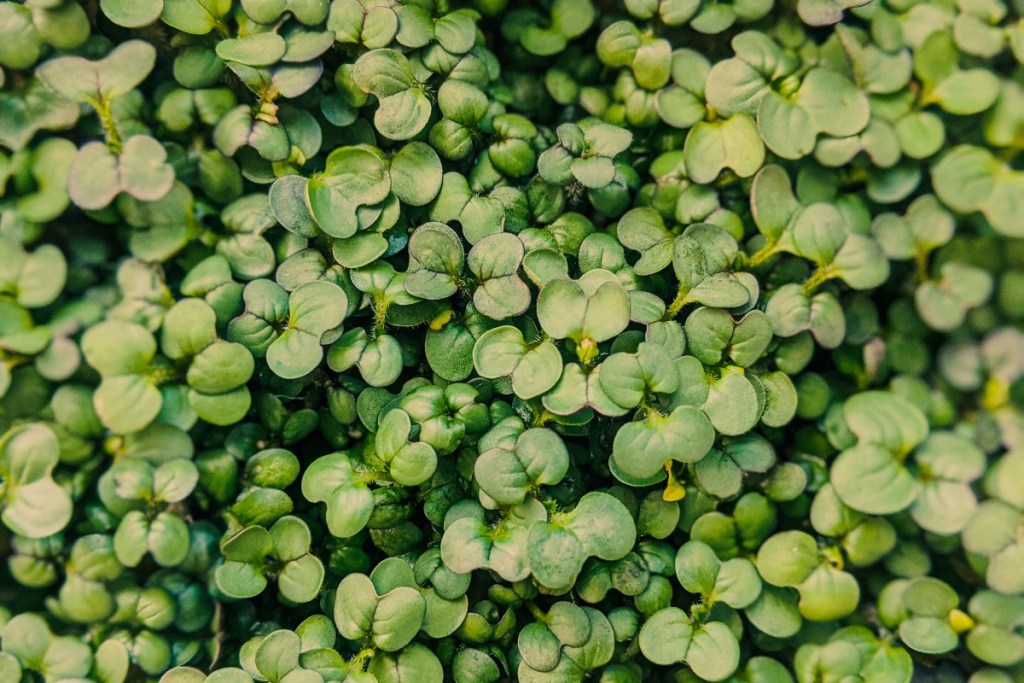Can small vegetable greens pack a punch for your health and tastebuds? That’s what chefs in California were betting on when they added microgreens to their menus in the 1980s.
What are microgreens? The U.S. Dept. of Agriculture says microgreens is technically a marketing term, and it refers to small green vegetables that come in many flavors, including spicy and sweet.
What are microgreens not? The term microgreens is often used interchangeably with sprouts or baby vegetables, but they are different.
People harvest sprouts after two to seven days. Microgreens are harvested one to three weeks after germination. By the time microgreens are harvested, their true leaves will have developed but not fully expanded. They’re typically about one to three inches tall, making them smaller than baby greens.
Despite their size, microgreens boast health benefits, and there are multiple types to consider. Let’s grow your knowledge.

What are some of the most popular types of microgreens?
There are many types of microgreens to choose from when crafting a menu. You can grow them from hundreds of different kinds of seeds. Once they’re all grown up, microgreens boast a variety of flavors and textures, from sweet to spicy and from crunchy to soft. Some of the most common types include:
- Asteraceae family: Lettuce and endive
- Apiaceae family: Dill, carrot, fennel, and celery
- Amaryllidaceae family: Garlic, onion, and leek
- Amaranthaceae family: Beets, chard, quinoa, and spinach
- Brassicaceae family: Arugula, broccoli, cabbage, cauliflower, and radish
- Cucurbitaceae family: Melons, cucumbers, and squashes
- Lamiaceae family: Mint, basil, and rosemary
- Poaceae family: Legumes, grasses, and cereals, such as beans, chickpeas, lentils, barley, corn, and rice
What are the health benefits of microgreens?
Don’t be fooled by the size — the list of microgreens’ health benefits is long. One 2015 study showed that microgreens boast more minerals, such as calcium, zinc, and magnesium, than mature lettuces. Earlier research found that microgreens had more antioxidant content than their grown-up counterparts. Because of their high nutritional content, microgreens may help lower the risk of some diseases and conditions. Here’s what researchers have found:
- Lower cholesterol. Research from 2016 suggests that consuming red cabbage microgreens may lower “bad” LDL cholesterol and triglycerides.
- Reduced risk of heart disease. Microgreens have a high concentration of polyphenols, an antioxidant, that may help lower heart disease, according to a 2013 study.
- Lower cancer risk. Polyphenols don’t simply help mitigate cardiovascular troubles. They can also lower the risk of cancer, though researchers cautioned more evidence is needed.
- Boost immune health. Red cabbage is a good source of vitamin C, which can help fight infections. Vitamin E, found in green daikon radishes, also supports immune health.
- Reduced risk of high blood pressure. One study of 30 varieties of microgreens found those from the Brassicaceae family (arugula, broccoli) boasted a ton of magnesium, which the NIH says helps keep blood pressure low.
How to enjoy microgreens
Aside from nutrition, microgreens can provide diversity to your diet. There are many ways to use them.
- Raw. Microgreens are tiny, making them portable. It’s easy to pop them into your mouth in between errands as a snack. You can also put them on salads or sandwiches.
- Garnish. Many restaurants use microgreens as a garnish to liven up baked potatoes, omelets, or grilled fish dishes. You can do the same in your kitchen.
- Extra flavor. Add an extra burst of flavor to pizza, soups, and pasta dishes by mixing in some microgreens.
- Drink them. Microgreens are perfect smoothie ingredients and can even spice up or sweeten drinks — including cocktails.
- Grow them. Aside from microgreens’ nutritional value and flavor, they are also something you can grow yourself. Gardening can help reduce stress and elevate happiness and self-esteem.
Microgreens are tiny. They’re harvested one to three weeks after germination, once some leaves have emerged but before they fully develop. Though they are small and often used as a garnish, research about microgreens’ health benefits suggests they’re incredibly nutritious. Some microgreen vegetables contain more vitamins, antioxidants, and minerals than the adult versions. Microgreens may help mitigate a variety of ailments, including blood pressure, immune health, heart disease, and cancer. However, it’s important to note other factors, such as genetics, play a role in these conditions. You can consume them raw or use them as ingredients in smoothies or soups. Microgreens are easy to grow yourself, so it may be a fun project that boosts your mental well-being.
BlissMark provides information regarding health, wellness, and beauty. The information within this article is not intended to be medical advice. Before starting any diet or exercise routine, consult your physician. If you don’t have a primary care physician, the United States Health & Human Services department has a free online tool that can help you locate a clinic in your area. We are not medical professionals, have not verified or vetted any programs, and in no way intend our content to be anything more than informative and inspiring.




